 About 40 students of the INSEAD business school from both the Singapore and the Fontainebleau campuses spent the week in Silicon Valley and attended various presentations and lectures, all remarkably coordinated by Dominique Trempont (left on the picture with three students, Mauricio from Colombia, Fawad from Pakistan and Philipp from Germany). I already spoke about INSEAD a while ago in a conversation with Eric Benhamou. This week, I was able to take a closer look at the exceptional value of this 12-month intensive MBA program, as well as the quality of the human experience provided by this truly international business school. The students who chose the Silicon Valley program are a subset of the 2009 class (others selected different places). I was impressed by this group of brilliant and open-minded folks born in about 25 different countries — and I was ever more impressed to find out that not all of them intend to pursue a career in high-tech. I have no idea how the admission process at INSEAD works, yet it’s clear from the sample I saw that the school is very good at identifying authentically curious people, those who, as Mark Twain said, are able to “Sail away from the safe harbor. Catch the trade winds in [their] sails. Explore. Dream. Discover.”
About 40 students of the INSEAD business school from both the Singapore and the Fontainebleau campuses spent the week in Silicon Valley and attended various presentations and lectures, all remarkably coordinated by Dominique Trempont (left on the picture with three students, Mauricio from Colombia, Fawad from Pakistan and Philipp from Germany). I already spoke about INSEAD a while ago in a conversation with Eric Benhamou. This week, I was able to take a closer look at the exceptional value of this 12-month intensive MBA program, as well as the quality of the human experience provided by this truly international business school. The students who chose the Silicon Valley program are a subset of the 2009 class (others selected different places). I was impressed by this group of brilliant and open-minded folks born in about 25 different countries — and I was ever more impressed to find out that not all of them intend to pursue a career in high-tech. I have no idea how the admission process at INSEAD works, yet it’s clear from the sample I saw that the school is very good at identifying authentically curious people, those who, as Mark Twain said, are able to “Sail away from the safe harbor. Catch the trade winds in [their] sails. Explore. Dream. Discover.”
I was one of the speakers invited by Dominique Trempont during the week. The theme of my lecture was “Starting a company: Thrills and Agonies.”
You can establish a list of reasons of why startups fail, and come up with 5, 10, 15, or 20 causes of failures depending on the angle you take. In the end, only one may be deadly: when a startup creates a product that nobody wants. In this presentation, I focused more specifically on one important factor that can improve the chances of succeeding: the depth and breadth of an entrepreneur’s commitment to his/her project, and subsequently, his/her ability to draw people to his/her cause.
Here below is the slideshow that I used and a short summary of the themes I discussed for 90 minutes. Over the next few weeks, I may discuss some of these slides more extensively.
 You may create a list of the do’s and don’ts. Yet, we all have to go through mistakes and agonies. Few are fatal by themselves. Remember that in ancient Greek “Agonia” is a mental struggle for victory and that “agein” means to lead! Agonies strengthen the determination to win, and this determination is based on the depth and breadth of your personal commitment. You need a little bit of luck. Sure, but you are able to manage on what you want to gamble and how you will gamble. In other words, you can build your luck.
You may create a list of the do’s and don’ts. Yet, we all have to go through mistakes and agonies. Few are fatal by themselves. Remember that in ancient Greek “Agonia” is a mental struggle for victory and that “agein” means to lead! Agonies strengthen the determination to win, and this determination is based on the depth and breadth of your personal commitment. You need a little bit of luck. Sure, but you are able to manage on what you want to gamble and how you will gamble. In other words, you can build your luck.
 Maybe you were born to be poet… But “oratores” – speakers are made, and so are entrepreneurs, who are first and foremost storytellers. If you cannot evangelize your product, this means that either you have no product to evangelize or that you are unwilling to carry the torch of your company. You may be shy today or wonder if you will ever be able to really make the jump. But the day you have the idea of a company, you have the stamina to defend and promote your idea. Even if you are awkward, your passion will come across.
Maybe you were born to be poet… But “oratores” – speakers are made, and so are entrepreneurs, who are first and foremost storytellers. If you cannot evangelize your product, this means that either you have no product to evangelize or that you are unwilling to carry the torch of your company. You may be shy today or wonder if you will ever be able to really make the jump. But the day you have the idea of a company, you have the stamina to defend and promote your idea. Even if you are awkward, your passion will come across.
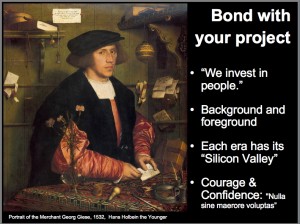 The strength of your bond with your project is a critical component of success and you often don’t know what you are capable of before you actually get into it. Your are more than you resume. Your “background” is not simply a resume – which is actually only a “foreground.” The real background of a person is the software that is running in the head and the heart of that person, is not being displayed but is operating. Or if you think of the “background” in painting, it is all the landscape, the objects or simply the light behind or around that person. This “background” says a lot about you, often silently. It says if you believe in what you do and how courageous you will be if needed.
The strength of your bond with your project is a critical component of success and you often don’t know what you are capable of before you actually get into it. Your are more than you resume. Your “background” is not simply a resume – which is actually only a “foreground.” The real background of a person is the software that is running in the head and the heart of that person, is not being displayed but is operating. Or if you think of the “background” in painting, it is all the landscape, the objects or simply the light behind or around that person. This “background” says a lot about you, often silently. It says if you believe in what you do and how courageous you will be if needed.
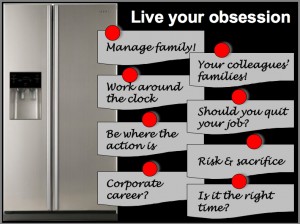 Entrepreneurs are dedicated to their project. In fact, their are obsessed by it. But they rarely live alone. So more often than not, they have to manage the risks and sacrifice associated to the fact of starting a company and they have to be aware that their goal may put some strain on their personal environment and family. So address all of this upfront. Also make sure that your colleagues also get their own family’s buy-in. A typical scenario that I have seen happen quite a few times: one of the founders promising his/her sweetheart that he/she wouldn’t on Saturdays or on Sundays or after hours or before a given hour. Fine… except for this: you’ll find bugs in your product when your most committed early adopters are ready to play with it, i.e. during weekends, at dawn or after hours. If your startup are not available to support them and eventually correct an obvious bug, how will you convince them to be committed to you if you are not unconditionally committed to them?
Entrepreneurs are dedicated to their project. In fact, their are obsessed by it. But they rarely live alone. So more often than not, they have to manage the risks and sacrifice associated to the fact of starting a company and they have to be aware that their goal may put some strain on their personal environment and family. So address all of this upfront. Also make sure that your colleagues also get their own family’s buy-in. A typical scenario that I have seen happen quite a few times: one of the founders promising his/her sweetheart that he/she wouldn’t on Saturdays or on Sundays or after hours or before a given hour. Fine… except for this: you’ll find bugs in your product when your most committed early adopters are ready to play with it, i.e. during weekends, at dawn or after hours. If your startup are not available to support them and eventually correct an obvious bug, how will you convince them to be committed to you if you are not unconditionally committed to them?
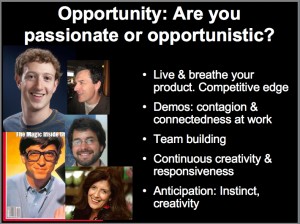 You may decide to become an entrepreneur and then, look for a good domain to start a business in. That’s possible. You may choose a “promising” area with the blessing of the best strategic marketers and analysts of the world, but the lack of a real symbiotic relationship between your goal for your company and your personal reality may come back to bite you. Will you have the right instinct should something unforeseen happen? Will you be able to understand your most passionate early adopters? It’s so much easier to evangelize a product that you live and breathe! Later down the road, when the company is established, this close relationship is not quite as important (your customer base speaks for you).
You may decide to become an entrepreneur and then, look for a good domain to start a business in. That’s possible. You may choose a “promising” area with the blessing of the best strategic marketers and analysts of the world, but the lack of a real symbiotic relationship between your goal for your company and your personal reality may come back to bite you. Will you have the right instinct should something unforeseen happen? Will you be able to understand your most passionate early adopters? It’s so much easier to evangelize a product that you live and breathe! Later down the road, when the company is established, this close relationship is not quite as important (your customer base speaks for you).
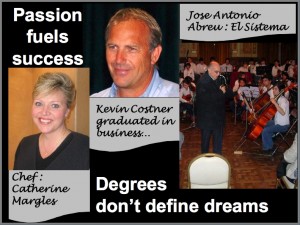 And your passion can be anything! Don’t feel obligated to choose a domain or a certain type of career just because you earned a business degree — it will be precious anyway. Don’t let people tell you “How come you invested money in an MBA [or whatever] to finally choose to do this! Or do not wrap yourself in some superiority complex. Degrees are not meant to curb dreams. Catherine Margles has an MBA from Kellogg and after 15 years in finance, she decided to pursue her dreams of cooking and writing. Look at the amazing life of José Antonio Abreu, an economist, who created the Foundation for the National Network of Youth and Children Orchestras of Venezuela – now El Sistema, arguably the most successful artistic organization in the world.
And your passion can be anything! Don’t feel obligated to choose a domain or a certain type of career just because you earned a business degree — it will be precious anyway. Don’t let people tell you “How come you invested money in an MBA [or whatever] to finally choose to do this! Or do not wrap yourself in some superiority complex. Degrees are not meant to curb dreams. Catherine Margles has an MBA from Kellogg and after 15 years in finance, she decided to pursue her dreams of cooking and writing. Look at the amazing life of José Antonio Abreu, an economist, who created the Foundation for the National Network of Youth and Children Orchestras of Venezuela – now El Sistema, arguably the most successful artistic organization in the world.
 Passion fuels another key factor for success: No matter how shy you may be, it gives you the desire to evangelize your idea, find co-founders, great early employees and build a network of like-minded individuals. The original team must be a group of contaminated people able to bounce back ideas. Eventually they may end up creating a product that is different from what was originally planned — and part along the way (this is the history of Blogger, which had started as PyraLabs and was supposed to be a web-based project and contact manager, and to-do list). Finding partners is a real viability test for your idea. If you can’t rally support for your project, why would you believe that you have a market?
Passion fuels another key factor for success: No matter how shy you may be, it gives you the desire to evangelize your idea, find co-founders, great early employees and build a network of like-minded individuals. The original team must be a group of contaminated people able to bounce back ideas. Eventually they may end up creating a product that is different from what was originally planned — and part along the way (this is the history of Blogger, which had started as PyraLabs and was supposed to be a web-based project and contact manager, and to-do list). Finding partners is a real viability test for your idea. If you can’t rally support for your project, why would you believe that you have a market?
 Another viability test is your ability to attract advisors, mentors and possibly angel investors — often entrepreneurs who have been involved in the field (or are simply interested in discovering a new domain and are willing to learn new things). In doing so, you rally the support of people who are outside your own circle or the circle of the people who are going to work with you. Their role is to help you, but also to challenge you. If you can’t get knowledgeable and committed advisors, see this as a warning sign. By the time you have enrolled co-founders and industry advisors, you have have a better idea of the value of your idea and if it is more than a marginal niche opportunity.
Another viability test is your ability to attract advisors, mentors and possibly angel investors — often entrepreneurs who have been involved in the field (or are simply interested in discovering a new domain and are willing to learn new things). In doing so, you rally the support of people who are outside your own circle or the circle of the people who are going to work with you. Their role is to help you, but also to challenge you. If you can’t get knowledgeable and committed advisors, see this as a warning sign. By the time you have enrolled co-founders and industry advisors, you have have a better idea of the value of your idea and if it is more than a marginal niche opportunity.
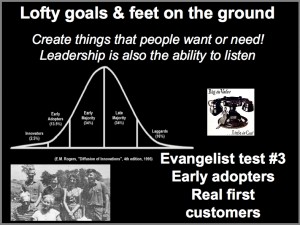 Talk to potential customers as soon as possible to refine your concept, the capabilities of your product or the definition of your service – and, of course, find early adopters as soon as you come up with an alpha offering. Leverage your network or simply pick up your phone. Listen to their feedback. Be ready to make adjustments almost on the fly. Leadership is also the art of listening. You all know the Rogers’ curve. He was the son a farmer from Iowa who had been reluctant to adopt a new hybrid drought resistant seed corn and saw his crop wither during the 1936 drought. Rogers studied agriculture. He had planned to become a farmer himself — but ended up dedicating his career to innovation processes.
Talk to potential customers as soon as possible to refine your concept, the capabilities of your product or the definition of your service – and, of course, find early adopters as soon as you come up with an alpha offering. Leverage your network or simply pick up your phone. Listen to their feedback. Be ready to make adjustments almost on the fly. Leadership is also the art of listening. You all know the Rogers’ curve. He was the son a farmer from Iowa who had been reluctant to adopt a new hybrid drought resistant seed corn and saw his crop wither during the 1936 drought. Rogers studied agriculture. He had planned to become a farmer himself — but ended up dedicating his career to innovation processes.
 Here is a summary of the steps to get your startup off the ground and improve your chances of success. Each step helps you test the viability of your business idea. Each step obliges you to evangelize and sell. By the time you have real early adopters and customers, you know that you have something. Then, execute and scale (if allowed by the nature of the business). You are not quite a startup any longer. You are a “young company.” This is a different topic.
Here is a summary of the steps to get your startup off the ground and improve your chances of success. Each step helps you test the viability of your business idea. Each step obliges you to evangelize and sell. By the time you have real early adopters and customers, you know that you have something. Then, execute and scale (if allowed by the nature of the business). You are not quite a startup any longer. You are a “young company.” This is a different topic.
Marylene Delbourg-Delphis
For more information about DominiqueTrempont: http://en.wikipedia.org/wiki/Dominique_Trempont
Earlier post: http://delbourg-delphis.com/2009/01/eric-benhamous-course-at-insead-from-start-up-to-fortune-500

3 responses so far ↓
1 Randy Nichols // Aug 20, 2009 at 6:29 pm
I found your site on technorati and read a few of your other posts. Keep up the good work. I just added your RSS feed to my Google News Reader. Looking forward to reading more from you down the road!
2 Sylvia // Aug 21, 2009 at 7:02 am
As in life, Marylene, passion is everything! Great post.
3 Bob Lowry // Aug 22, 2009 at 5:01 am
Marylene,
As a life long entrepreneur and student of entrepreneurship I salute you. You are a communicator and a pragmatist. You see the truth and you can relay it to others without ego or pretense.
Thank you for having the initiative and the wisdom to share what you’ve learned as a vocation and as a matter of course.
Bob
Leave a Comment